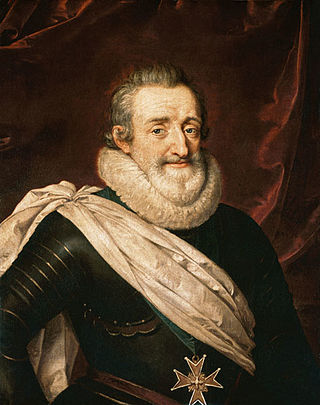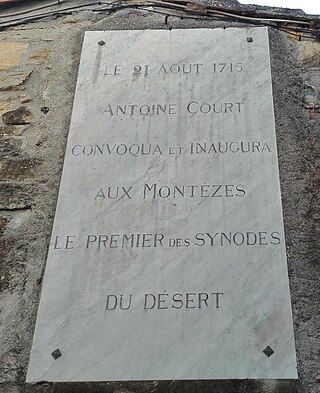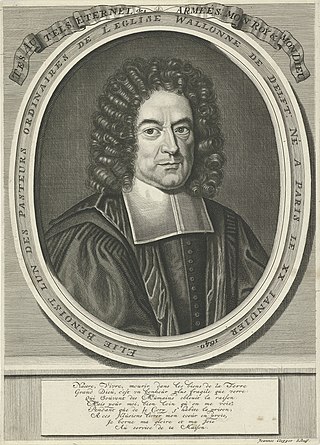
The Edict of Nantes was signed in April 1598 by King Henry IV and granted the minority Calvinist Protestants of France, also known as Huguenots, substantial rights in the nation, which was predominantly Catholic.

The Huguenots were a religious group of French Protestants who held to the Reformed (Calvinist) tradition of Protestantism. The term, which may be derived from the name of a Swiss political leader, the Genevan burgomaster Besançon Hugues (1491–1532), was in common use by the mid-16th century. Huguenot was frequently used in reference to those of the Reformed Church of France from the time of the Protestant Reformation. By contrast, the Protestant populations of eastern France, in Alsace, Moselle, and Montbéliard, were mainly Lutherans.

The French Wars of Religion were a series of civil wars between French Catholics and Protestants from 1562 to 1598. Between two and four million people died from violence, famine or disease directly caused by the conflict, and it severely damaged the power of the French monarchy. One of its most notorious episodes was the St. Bartholomew's Day massacre in 1572. The fighting ended with a compromise in 1598, when Henry of Navarre, who had converted to Catholicism in 1593, was proclaimed King Henry IV of France and issued the Edict of Nantes, which granted substantial rights and freedoms to the Huguenots. However, Catholics continued to disapprove of Protestants and of Henry, and his assassination in 1610 triggered a fresh round of Huguenot rebellions in the 1620s.

Pierre Jurieu was a French Protestant leader.

The Edict of Fontainebleau was an edict issued by French King Louis XIV and is also known as the Revocation of the Edict of Nantes. The Edict of Nantes (1598) had granted Huguenots the right to practice their religion without state persecution. Protestants had lost their independence in places of refuge under Cardinal Richelieu on account of their supposed insubordination, but they continued to live in comparative security and political contentment. From the outset, religious toleration in France had been a royal, rather than popular, policy.

Paul Rabaut was a French pastor of the Huguenot "Church of the Desert". He was regarded by many as the leader and director of the proscribed church. He was a peacemaker and a scholar despite, due to persecution, living like a troglodyte for more than 30 years.
Camisards were Huguenots of the rugged and isolated Cévennes region and the neighbouring Vaunage in southern France. In the early 1700s, they raised a resistance against the persecutions which followed Louis XIV's Revocation of the Edict of Nantes, making Protestantism illegal. The Camisards operated throughout the mainly Protestant Cévennes and Vaunage regions including parts of the Camargue around Aigues Mortes. The revolt broke out in 1702, with the worst of the fighting continuing until 1704, then skirmishes until 1710 and a final peace by 1715. The Edict of Tolerance was not finally signed until 1787.

The Dragonnades was a policy implemented by Louis XIV in 1681 to force French Protestants known as Huguenots to convert to Catholicism. It involved the billeting of dragoons of the French Royal Army in Huguenot households, with the soldiers being given implied permission to mistreat the inhabitants and damage or steal their possessions. Soldiers employed as part of this policy were derisively referred to as "missionary dragoons".

Daniel Chamier (1564–1621) was a Huguenot minister in France, founder of the Academy of Montpellier and author.

Jean Daillé was a French Huguenot minister and Biblical commentator. He is mentioned in James Aitken Wylie's History of Protestantism as author of an Apology for the French Reformed Churches.

The Reformed Church of France was the main Protestant denomination in France with a Calvinist orientation that could be traced back directly to John Calvin. In 2013, the Church merged with the Evangelical Lutheran Church in France to form the United Protestant Church of France.

Antoine Court was a French reformer called the "Restorer of Protestantism in France." He was born in Villeneuve-de-Berg, in Languedoc, on 27 March 1696, although at least one source lists a different date. His parents were peasants, adherents of the Reformed church, which was at the time a target of state persecution following the 1685 Edict of Fontainebleau.
Pierre des Maizeaux, also spelled Desmaizeaux, was a French Huguenot writer exiled in London, best known as the translator and biographer of Pierre Bayle.

Many people of European heritage in South Africa are descended from Huguenots. Most of these originally settled in the Cape Colony, but were absorbed into the Afrikaner and Afrikaans-speaking population, because they had religious similarities to the Dutch colonists.
The Harache family is a family of goldsmiths of Huguenot extraction, many of whom came to London from France towards the end of the 17th century to avoid persecution. They were responsible for some of England’s most important silversmithing of the time. The family was active in the production of silver plate in London for about a hundred years.

Protestantism in France has existed in its various forms, starting with Calvinism and Lutheranism since the Protestant Reformation. John Calvin was a Frenchman, as were numerous other Protestant Reformers including William Farel, Pierre Viret and Theodore Beza, who was Calvin's successor in Geneva. Peter Waldo was a merchant from Lyon, who founded a pre-Protestant group, the Waldensians. Martin Bucer was born a German in Alsace, which historically belonged to the Holy Roman Empire, but now belongs to France.

Élie Benoist, was a French Protestant minister, known as a historian of the Edict of Nantes.

The French Protestant Church of London is a Reformed / Presbyterian church that has catered to the French-speaking community of London since 1550. It is the last remaining Huguenot church of London. Its current temple in Soho Square is a Grade II* listed building designed by Aston Webb and erected in 1891–93.
Valérand Poullain (1509?–1557) was a French Calvinist minister. In a troubled career as minister, he was pastor to a congregation of Flemish or Walloon weavers brought to Southwest England around 1548.

Marie Durand (1711–1776), was a French Protestant. She was famously imprisoned in the Tour de Constance (Aigues-Mortes) from 25 August 1730 for attending a Huguenot assembly with her mother, or perhaps because her brother, Pierre Durand, was a well-known preacher, or perhaps because of her marriage.


















